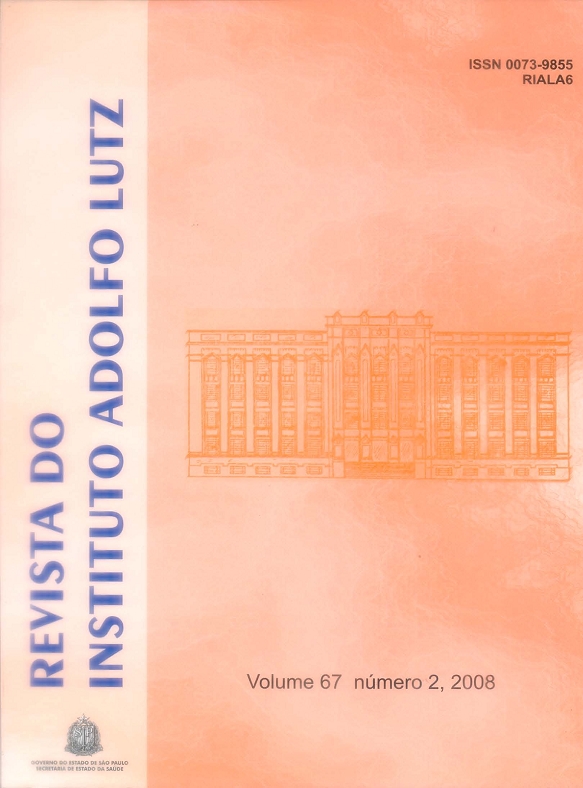Resumo
A Leishmaniose é uma doença tropical endêmica que afeta principalmente países em desenvolvimento. O arsenal terapêutico da Leishmaniose é muito restrito e altamente tóxico, tendo como base o uso dos sais de antimônio. Os fármacos de segunda escolha como a anfotericina B e a pentamidina também apresentam elevada toxicidade e, assim, nenhuma terapia recente é efetiva contra Leishmania spp. Lipossomos são sistemas carreadores de fármacos, que podem direcionar altas doses a células alvo. No presente trabalho foi desenvolvida uma nova formulação lipossomal com o objetivo de direcionar o antimônio pentavalente aos macrófagos infectados com Leishmania (L.) chagasi, por meio da interação com receptores scavengers in vivo. A formulação de antimônio lipossomal demonstrou elevada eficácia in vivo, reduzindo 133 vezes a dose total de antimônio administrada, com diminuição de 100% da carga parasitária do fígado na dose de 0,75 mg/kg. Estudos em microscopia eletrônica de transmissão revelaram uma formulação estável e de aspecto oligolamelar. Estudos do potencial zeta demonstraram carga negativa acoplada à superfície dos lipossomos, derivada da adição de fosfatidilserina. Esta nova abordagem vem contribuir no estudo de novas formulações lipossomais para redução da toxicidade de fármacos no tratamento da Leishmaniose.Referências
1. Guerin PJ, Olliaro P, Sundar S, Boelaert M, Croft SL, Desjeux P,Wasunna MK, Bryceson ADM. Visceral leishmaniasis: current statusof control, diagnosis, and treatment, and a proposed research anddevelopment agenda. Lancet Infect Dis. 2002; 2: 494-01.
2. Vianna GO. Tratamento da Leishmaniose tegumentar por injeções intravenosas de tártaro emético. An 7O Congr Bras Med Cirurg. 1912;4: 426-28.
3. Croft SL, Coombs GH. Leishmaniasis– current chemotherapy andrecent advances in the search for novel drugs. Trends Parasitol.2003;19:502-8.
4. Dube A, Singh N, Sundar S, Singh N. Refractoriness to the treatmentof sodium stibogluconate in Indian kala-azar field isolates persist in invitro and in vivo experimental models. Parasitol Res. 2005; 96: 216-23.
5. Soto J, Berman J. Treatment of New World cutaneous leishmaniasis with miltefosine. Trans R Soc Trop Med Hyg. 2006;100:34-40.
6. Gulati M, Grover M, Singh S, Singh M. Lipophilic drug derivatives inliposomes. Int J Pharm. 1998; 165: 129-68.
7. Sharma A, Sharm US. Liposomes in drug delivery: progress andlimitations. Int J Pharm. 1997;154:123-40.
8. Fadok VA, Bratton DL, Guthrie L, Henson PM. Differential effects of apoptotic versus lysed cells on macrophage production of cytokines: role of proteases. J Immunol. 2001; 166: 6847-54.
9. Tempone AG, Perez D, Rath S, Vilarinho AL, Mortara RA, Andrade JrHF. Targeting Leishmania (L.) chagasi amastigotes throughmacrophage scavenger receptors: the use of drugs entrapped inliposomes containing phosphatidylserine. J Antimicrob Chemother.2004;54:60-8.
10. Stauber LA, Franchino EM, Grun, J. An eight-day method for screening compounds against Leishmania donovani in golden hamsters. JProtozool. 1958; 5, 269-73.
11. Stewart JCM. Colorimetric determination of phospholipids withammonium ferrothiocyanate. Anal Biochem. 1980; 104:10-4.
12. New RRC. Liposomes: a practical approach. University Press, Oxford,1992; p. 140-45.
13. Ciani L, Ristori S, Salvati A, Calamai L, Martini G. DOTAP/DOPEand DC-Chol/DOPE lipoplexes for gene delivery: zeta potential measurements and electron spin resonance spectra. Biochim Biophys Acta. 2004;1664: 70–9.
14. Garnier T, Mäntylä A, Järvinen T, Lawrence J, Brown M, Croft S. Invivo studies on the antileishmanial activity of buparvaquone and itsprodrugs. J Antimicrob Chemother. 2007;60:802-10.
15. Bradley DJ, Kirkley J. Regulation of Leishmania populations withinthe host. I. The variable course of Leishmania donovani infections inmice. Clin Exp Immunol.1977;30: 119–29.
16. New RR, Chance ML, Thomas SC, Peters W. Antileishmanial activityof antimonials entrapped in liposomes. Nature. 1978; 2:55-6.
17. Hunter CA, Dolan TF, Coombs GH, Baillie AJ. Vesicular systems(niosomes and liposomes) for delivery of sodium stibogluconate inexperimental murine visceral leishmaniasis. J Pharm Pharmacol.1988;40:161-5.
18. Pal S, Ravindran R, Ali N. Combination therapy using sodium antimonygluconate in stearylamine-bearing liposomes against established andchronic Leishmania donovani infection in BALB/c Mice. AntimicrobAgents Chemother. 2004;48:3591-3.
19. Collins M, Carter KC, Baillie AJ. Visceral leishmaniasis in the BALB/c mouse: antimony tissue disposition and parasite suppression afterthe administration of free stibogluconate. Ann Trop Med Parasitol.1992;86:35-40.
20. Baillie AJ, Dolan TF, Alexander J, Carter KC. Visceralleishmaniasis in BALB/c mouse: sodium stibogluconate treatement during acute and chronic stages of infection. Int JPharm. 1989;57:23-8.
21. Szoka F, Jacobson K, Derzko Z, Papahadjopoulos D. Fluorescencestudies on the mechanism of liposome-cell interactions in vitro.Biochim Biophys Acta. 1980; 600: 1-18.
22. Zuidam NJ, Lee SS, Crommelin DJ. Sterilization of liposomes by heattreatment. Pharm Res. 1993;10:1591-6.
23. Kokkona M, Kallinteri P, Fatouros D, Antimisiaris SG. Stabilityof SUV liposomes in the presence of cholate salts and pancreaticlipases: effect of lipid composition. Eur J Pharm Sci. 2000;9:245-52.
24. Abra RM, Hunt CA. Liposome disposition in vivo IV: the interactionof sequential doses of liposomes having different diameters. Res Commun Chem Pathol Pharmacol. 1982;36:17-31.
25. Carter KC, Dolan TF, Alexander J, Baillie AJ, McColgan C. Visceralleishmaniasis: drug carrier system characteristics and the ability toclear parasites from the liver, spleen and bone marrow in Leishmaniadonovani infected BALB/c mice. J Pharm Pharmacol. 1989; 41:87-91.
26. Oku N, Tokudome Y, Namba Y, Saito N, Endo M, Hasegawa Y, KawaiM, Tsukada H, Okada S. Effect of serum protein binding on real-timetrafficking of liposomes with different charges analyzed by positronemission tomography. Biochim Biophys Acta. 1996; 1280:149-54.
27. Fadok VA, Bratton DL, Rose DM, Pearson A, Ezekewitz RA, HensonPM. A receptor for phosphatidylserine-specific clearance of apoptoticcells. Nature. 2000; 405: 85-90.

Este trabalho está licenciado sob uma licença Creative Commons Attribution 4.0 International License.
Copyright (c) 2008 André Gustavo Tempone, Heitor Franco de Andrade JR.
